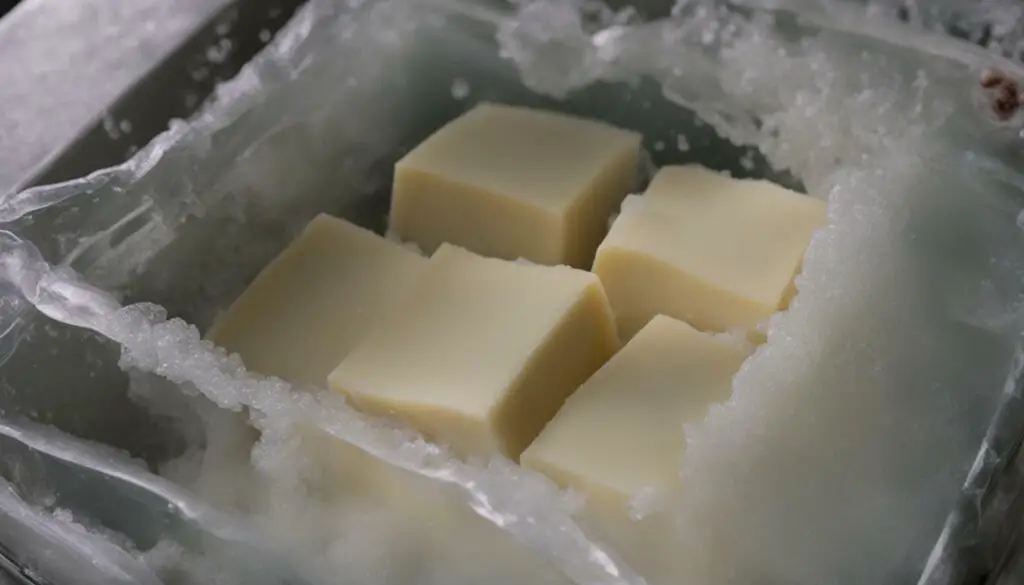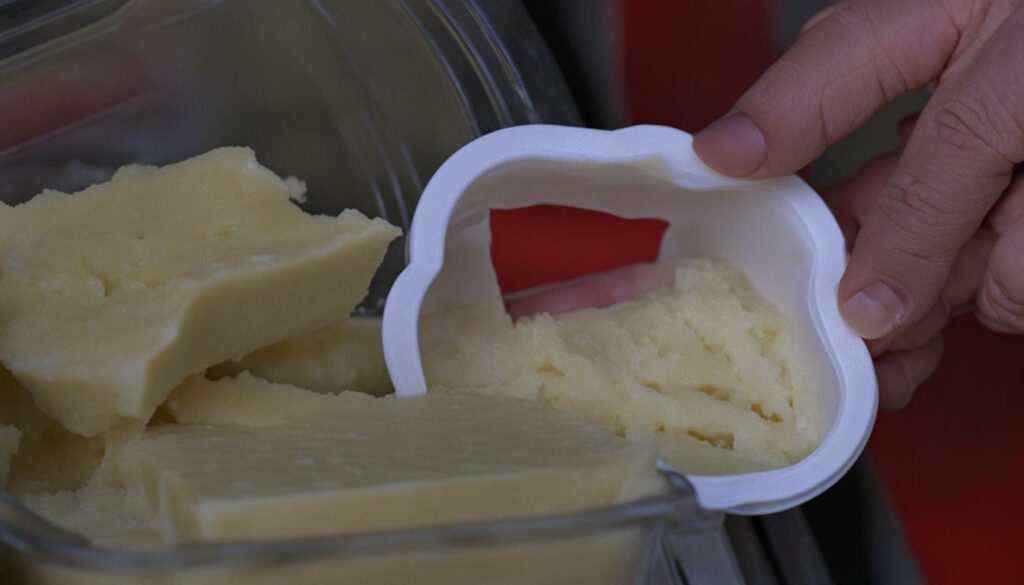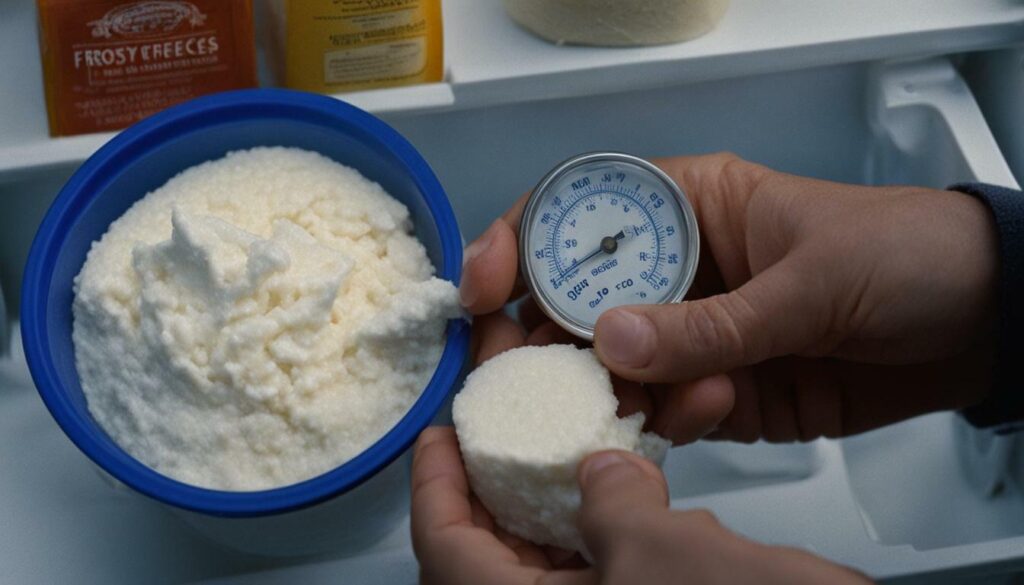If you’ve ever wondered, “Can you freeze queso fresco?” we’ve got you covered. In this comprehensive guide, we will explore the proper storage and freezing techniques for this popular cheese.
If you love queso fresco, you may have found yourself with a surplus and wondered how to prolong its freshness. Freezing queso fresco is possible, but it’s important to understand the effects it can have on the cheese.
When queso fresco is frozen, the water content inside the cheese turns into ice crystals, causing some moisture loss and resulting in a change in texture. The cheese will become less soft and may lose some of its mild flavor.
While frozen queso fresco is safe to consume after defrosting, it is best to use it within 2-3 days to ensure optimal taste and texture.
Key Takeaways:
Contents
- 1 Freezing Queso Fresco: Tips and Guidelines
- 2 Proper Packaging for Freezing Queso Fresco
- 3 Freezing and Thawing Queso Fresco: Step-by-Step Guide
- 4 Storing Queso Fresco in the Refrigerator
- 5 Signs of Spoilage and Shelf Life
- 6 Conclusion – So can you freeze Queso Fresco?
- 7 Find out more about Queso Fresco
- 8 Is Queso Fresco Healthy? Unveiling the Truth | Our Discovery.
- 9 Oaxaca Cheese vs Queso Fresco: Unveiling the Delicious Mystery
- 10 Understanding Queso Fresco in English – A Cheesy Delight!
- 11 Queso Fresco Vs Feta: Unveiling the Cheesy Differences
- 12 Discover How to Store Queso Fresco with Our Easy Tips!
- 13 Unraveling the Mystery: Does Queso Fresco Melt?
- 14 Queso Fresco vs Mozzarella: Exploring Cheesy Differences
- 15 Finding the Perfect Substitute for Queso Fresco – Your Guide
- 16 FAQ
- 16.1 Q: Can you freeze queso fresco?
- 16.2 Q: What happens to queso fresco when it’s frozen?
- 16.3 Q: How should I package queso fresco for freezing?
- 16.4 Q: How long can queso fresco be kept in the freezer?
- 16.5 Q: How should I thaw queso fresco?
- 16.6 Q: Can I refreeze queso fresco?
- 16.7 Q: How long can queso fresco be stored in the refrigerator?
- 16.8 Q: How can I tell if queso fresco has gone bad?
- Freezing queso fresco is possible, but it may alter the texture and flavor.
- Wrap queso fresco in aluminum foil and place it in an airtight ziplock bag before freezing.
- Thaw frozen queso fresco in the refrigerator for approximately 8 hours.
- Drain excess water from defrosted queso fresco before using it.
- Refreezing queso fresco is not recommended.
Freezing Queso Fresco: Tips and Guidelines
Freezing queso fresco requires a few simple steps to ensure that its texture and flavor are preserved during storage. While the cheese will undergo changes in both of these aspects, following the right techniques can help minimize any negative effects. Here are some helpful tips for freezing and thawing queso fresco:
- Wrap it right: To protect queso fresco during freezing, wrap it tightly in aluminum foil. This will help prevent freezer burn and maintain its quality. After wrapping the cheese, place it in an airtight ziplock bag to provide an extra layer of protection.
- Freezer duration: Queso fresco can be stored in the freezer for up to two months. However, it is best to use it within this time frame to ensure optimal taste and texture.
- Thawing process: When it’s time to thaw queso fresco, transfer it from the freezer to the refrigerator. Allow it to thaw for approximately 8 hours or overnight. This gradual thawing will help preserve its texture and flavor.
- Drain excess water: As queso fresco thaws, some water will be released from the cheese. To avoid a watery consistency, carefully drain any excess water before using the cheese. This will help maintain its desired texture.
Remember, once queso fresco is frozen, it is not recommended to refreeze it, as this can further affect its texture. Instead, use it within a few days after thawing. If you prefer a longer shelf life without freezing, storing queso fresco in the refrigerator is an excellent alternative. When kept unopened, it can last for up to a week.
Preserving Queso Fresco: A Versatile Cheese
Queso fresco is a versatile cheese that lends itself to various culinary applications. Although freezing may alter its texture and flavor, it can still be used in several dishes. From crumbling it over salads to melting it in warm dishes, there are many ways to enjoy queso fresco even after freezing. Its mild and creamy taste adds a delightful touch to many recipes.
So, whether you choose to freeze or refrigerate queso fresco, it’s essential to make the most of this delicious cheese. By following these tips and guidelines, you can ensure that your queso fresco retains its best qualities, allowing you to savor its unique flavor and texture in your favorite dishes.

While it is possible to freeze queso fresco, it’s important to note that the freezing process alters its texture and taste. When queso fresco is frozen, the water content within the cheese turns into ice crystals, causing the cheese to become slightly crumbly and lose some of its softness. Additionally, the mild flavor of the cheese may become slightly subdued after freezing. However, despite these changes, frozen queso fresco is still safe to consume and can be used in various dishes.
When it comes to freezing and thawing queso fresco, it’s crucial to follow the proper steps to maintain its best quality. Start by wrapping the cheese tightly in aluminum foil to prevent freezer burn. Then, place the wrapped cheese in an airtight ziplock bag to provide an extra layer of protection against moisture and odors in the freezer.
It is recommended to use the frozen queso fresco within two months for optimal flavor and texture. When defrosting the cheese, transfer it from the freezer to the refrigerator and allow it to thaw for approximately 8 hours. This slow thawing process helps to retain the cheese’s moisture and minimize any further changes in texture. Before using the queso fresco, make sure to drain any excess water that may have accumulated during thawing.
Refreezing queso fresco is not advisable, as it can further deteriorate the texture and overall quality of the cheese. Instead, if you have leftover queso fresco that you know you won’t use within a few days, it’s better to store it in the refrigerator. Unopened queso fresco can last for up to a week when properly refrigerated. However, always check for signs of spoilage such as a sour smell, mold growth, unusual color, or a dry and crumbly texture before consuming.

- Freezing alters the texture and taste of queso fresco
- Wrap queso fresco tightly in aluminum foil and store in an airtight ziplock bag when freezing
- Use frozen queso fresco within two months for best results
- Thaw queso fresco in the refrigerator for about 8 hours and drain excess water before using
- Do not refreeze queso fresco
- Unopened queso fresco can be stored in the refrigerator for up to a week
- Check for signs of spoilage before consuming
Proper Packaging for Freezing Queso Fresco
To freeze queso fresco successfully, proper packaging is key to preserving its taste and texture. When storing this delightful Mexican cheese in your freezer, follow these guidelines to ensure it remains delicious:
- Start by wrapping the queso fresco tightly in aluminum foil. This will help protect it from freezer burn and maintain its moisture.
- Next, place the wrapped queso fresco in an airtight ziplock bag. Squeeze out any excess air before sealing it tightly. This extra layer of protection will prevent any odors from contaminating the cheese and help maintain its freshness.
- Label the bag with the date of freezing to keep track of its storage time. Queso fresco can be kept in the freezer for up to two months.
- If you prefer to freeze smaller portions, divide the queso fresco into individual servings before packaging. This makes it easier to thaw only what you need, reducing waste.
Properly packaging queso fresco before freezing ensures that it maintains its quality and flavor, allowing you to enjoy its creamy goodness even after it has been defrosted.
Tips for Freezing Queso Fresco:
“By carefully packaging queso fresco for freezing, you can extend its shelf life and enjoy its taste and texture even months after it was made.”
Not only does proper packaging keep the delicate taste and texture intact, but it also helps prevent contamination and freezer burn. By following these tips, you’ll be able to enjoy the same freshness and creaminess that makes queso fresco such a popular choice:
- Always wrap the queso fresco tightly to prevent air exposure, which can lead to drying and loss of quality.
- Ensure that the foil and ziplock bag are airtight to prevent odors from affecting the cheese’s flavor.
- Label and date the packaging to keep track of its storage time and make it easier to identify in the freezer.
- Consider freezing smaller portions to thaw only what you need, minimizing waste and ensuring maximum freshness.

With these proper packaging techniques, you can freeze queso fresco with confidence, knowing the cheese will retain its taste and texture until you’re ready to enjoy it.
Freezing and Thawing Queso Fresco: Step-by-Step Guide
Follow these simple steps to freeze and thaw queso fresco properly for optimal taste and texture:
- Start by wrapping the queso fresco tightly in aluminum foil. This will help protect it from freezer burn and maintain its quality.
- Place the wrapped cheese in an airtight ziplock bag, squeezing out any excess air before sealing it. This will further prevent freezer burn and keep the cheese fresh.
- Label the bag with the date of freezing to keep track of its storage time.
- Now, it’s time to freeze the queso fresco. Find a flat surface in your freezer where the cheese can lay flat without being bumped or crushed. This will help maintain its shape.
- Allow the queso fresco to freeze for at least two hours before transferring it to a more long-term storage location in the freezer.
- When it’s time to thaw the queso fresco, move it from the freezer to the refrigerator. This slow thawing process will help preserve its texture and flavor.
- Let the queso fresco thaw for approximately 8 hours in the refrigerator. This will ensure it thaws evenly and reduces the risk of any undesirable texture changes.
- Once thawed, drain any excess water that may have been released from the cheese. This step will help maintain its desired texture.
- Now, your queso fresco is ready to use in your favorite recipes!
Remember, it is not advisable to refreeze queso fresco. Doing so will further deteriorate its texture and compromise its quality. It’s best to use the cheese within 2-3 days after thawing. Storing queso fresco in the refrigerator is another option, offering a longer shelf life of up to a week if unopened.
When determining if queso fresco has gone bad, check for a sour smell, mold growth, unusual color, and a dry or crumbly texture. If any of these signs are present, it’s best to discard the cheese.

Properly freezing and thawing queso fresco is essential to preserve its deliciousness. By following these easy steps, you can ensure that your frozen queso fresco maintains its soft texture and mild flavor when ready to use. So, go ahead and freeze your queso fresco with confidence, knowing that it will be just as tasty when thawed!
Storing Queso Fresco in the Refrigerator
If you prefer not to freeze your queso fresco, storing it in the refrigerator is a viable option for preserving its freshness. When properly stored, queso fresco can last up to a week in the fridge, ensuring you have delicious cheese ready for your favorite recipes.
To store queso fresco in the refrigerator, follow these simple steps:
- Keep the original packaging intact if unopened. The packaging is designed to protect the cheese from outside contaminants and maintain its quality.
- If the cheese is already opened, transfer it to an airtight container or wrap it tightly in plastic wrap to prevent air exposure and limit moisture loss.
- Store the queso fresco in the coldest part of your refrigerator, such as the main body or the cheese drawer. This helps maintain a consistent temperature, ensuring optimal freshness.

Remember to check the cheese periodically for signs of spoilage. If you notice a sour smell, mold growth, unusual color, or a dry and crumbly texture, it’s best to discard the cheese to avoid any health risks.
By following these storage guidelines, you can enjoy queso fresco in all its creamy goodness whenever you’re ready to use it!
Signs of Spoilage and Shelf Life
It’s essential to know how to recognize signs of spoilage in queso fresco and understand its shelf life to ensure safe consumption. While queso fresco can be frozen, it is important to be vigilant for any indications that the cheese has gone bad.
Here are some key signs to look out for:
- Sour smell: If the queso fresco emits a strong sour or unpleasant odor, it is a clear indication that it has spoiled.
- Mold growth: Visible mold on the cheese is a sign of spoilage. If you notice any fuzzy or discolored patches, it’s best to discard the cheese.
- Unusual color: Queso fresco should have a white or creamy color. If you observe any unusual hues, such as green or blue, it is a sign that the cheese has deteriorated.
- Dry or crumbly texture: Fresh queso fresco should have a soft and slightly crumbly texture. If the cheese feels excessively dry or crumbly, it may be past its prime.
When properly stored in the refrigerator, unopened queso fresco can last for up to a week. However, once opened, it is advisable to consume it within a few days to maintain its best quality.

Queso fresco is a perishable product, so it’s important to be mindful of its shelf life. The cheese should be consumed before the expiration date indicated on the packaging.
It’s worth noting that the shelf life of queso fresco can vary depending on different factors, such as storage conditions, the freshness of the cheese when purchased, and any additional ingredients or seasonings used.
By regularly checking for signs of spoilage and following proper storage guidelines, you can enjoy queso fresco safely and savor its delicious flavor and creamy texture.
Conclusion – So can you freeze Queso Fresco?
In conclusion, while queso fresco can be frozen, it undergoes changes in texture and flavor, making it best to consume within a few days of thawing. When frozen, the water content in the cheese turns into ice crystals, causing a loss of softness. Although it is safe to eat after defrosting, the cheese may become slightly drier and less creamy.
To freeze queso fresco, wrap it tightly in aluminum foil to protect it from freezer burn and moisture. Place the wrapped cheese in an airtight ziplock bag to further prevent freezer odors from affecting its taste. Store the packaged queso fresco in the freezer for up to two months.
When you’re ready to use the cheese, transfer it from the freezer to the refrigerator for thawing. Allow it to defrost for about 8 hours or overnight. During this time, excess water may be released, so it’s essential to drain it before incorporating the queso fresco into your dishes.
It’s important to note that refreezing queso fresco is not recommended, as it will further compromise its texture and quality. Therefore, it’s best to freeze the cheese in small portions that can be used up within a few days after thawing.
Alternatively, storing queso fresco in the refrigerator is a better option if you plan to consume it within a week. If unopened, the cheese can last for up to a week in the refrigerator. However, always check for signs of spoilage, such as a sour smell, mold growth, unusual color, or a dry and crumbly texture, before using the cheese.
Find out more about Queso Fresco
FAQ
Q: Can you freeze queso fresco?
A: Yes, queso fresco can be frozen. However, it will lose its soft texture and mild flavor in the process.
Q: What happens to queso fresco when it’s frozen?
A: Freezing queso fresco causes the water content in the cheese to turn into ice crystals, resulting in a change in texture.
Q: How should I package queso fresco for freezing?
A: Wrap the queso fresco in aluminum foil and place it in an airtight ziplock bag.
Q: How long can queso fresco be kept in the freezer?
A: Queso fresco can be kept in the freezer for up to two months.
Q: How should I thaw queso fresco?
A: Move the frozen queso fresco to the fridge and allow it to thaw for about 8 hours. Drain excess water before using.
Q: Can I refreeze queso fresco?
A: It is not advisable to refreeze queso fresco as it will further deteriorate the texture.
Q: How long can queso fresco be stored in the refrigerator?
A: If unopened, queso fresco can last for up to a week in the refrigerator.
Q: How can I tell if queso fresco has gone bad?
A: Check for a sour smell, mold growth, unusual color, and dry or crumbly texture to determine if queso fresco has gone bad.

1 thought on “Can You Freeze Queso Fresco? Our Guide to Proper Storage”